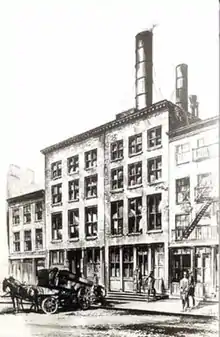Pearl Street Station
Pearl Street Station was the first commercial central power plant in the United States. It was located at 255–257 Pearl Street in the Financial District of Manhattan, New York City, just south of Fulton Street on a site measuring 50 by 100 feet (15 by 30 m).[1] The station was built by the Edison Illuminating Company, under the direction of Francis Upton, hired by Thomas Edison.

Pearl Street Station was fired by coal; it began with six dynamos, and it started generating electricity on September 4, 1882, serving an initial load of 400 lamps at 82 customers.[2] By 1884, Pearl Street Station was serving 508 customers with 10,164 lamps.[1] The station was originally powered by custom-made Porter-Allen high-speed steam engines designed to provide 175 horsepower at 700 rpm,[3]:529 but these proved to be unreliable with their sensitive governors. They were removed and replaced with new engines from Armington & Sims that proved to be much more suitable for Edison's dynamos.[3]:527 Pearl Street Station was also the world's first cogeneration plant.[4] While the steam engines provided grid electricity, Edison made use of the thermal byproduct by providing steam heating to local manufacturers and nearby buildings on the same Manhattan block.
Pearl Street Station served what was known as the "First District" (bounded clockwise from north by Spruce Street, the East River, Wall Street, and Nassau Street). The district, so named because of its importance in the history of electric power, contained several other power stations such as the Excelsior Power Company Building.[5][6] The station burned down in 1890, destroying all but one dynamo that is now kept in the Greenfield Village Museum in Dearborn, Michigan.[7]
Scale models
In 1929 the Edison Company constructed three scale working models of the station. When a button was pushed, a motor turned the engines, generators, and other equipment in the model. A set of lamps connected to labelled buttons identified the various areas of the building. Cut-outs in the side of the model building allowed examination of the boilers on the first level, reciprocating steam engines and dynamos on the reinforced second level, and the control and test gear on the third and fourth levels. The models were constructed to a scale of one-half inch to the foot and were 62 inches long, 34 inches high and 13 inches wide. The models still exist and are on display at the Smithsonian Institution's National Museum of American History in Washington, D.C.; at the Consolidated Edison Learning Center in Long Island City, New York; and at the Henry Ford Museum in Dearborn, Michigan. Up to 31 people worked on constructing the models which took about 6 months to complete.[6]
See also
- Holborn Viaduct power station
- Schuyler Wheeler
- War of the currents
- Schoellkopf Power Station - Direct current at Niagara Falls
References
- Josephson, Matthew (1959). Edison: a biography / Matthew Josephson. New York: McGraw-Hill. p. 255. OCLC 1155696415.
- Skruen uden ende, page 253, third edition
- Electrical World. McGraw-Hill. 1922.
- Industrial Motor Power Corp, What is Cogeneration?
- "Excelsior Steam Power Company Building" (PDF). New York City Landmarks Preservation Commission. December 13, 2016. p. 5. Retrieved 2020-09-10.
- Sulzberger, Carl (March–April 2013). "Pearl Street in Miniature: models of the electric generating station". IEEE Power & Energy Magazine. 11 (2). Retrieved September 8, 2020.
- "Powering New York City and Westchester". Con Edison. Retrieved September 10, 2020.
External links
| Wikimedia Commons has media related to Pearl Street Station. |
- Pearl Street Station from the IEEE Global History Network
- Edison: His Life and Inventions
- Industrial Motor Power Corp., What is Cogeneration?
- Edison Electric Institute. History of the Electric Power Industry. Retrieved 13 April 2005.
- Smithsonian Institution. Emergence of Electrical Utilities in America. Retrieved 13 April 2005.